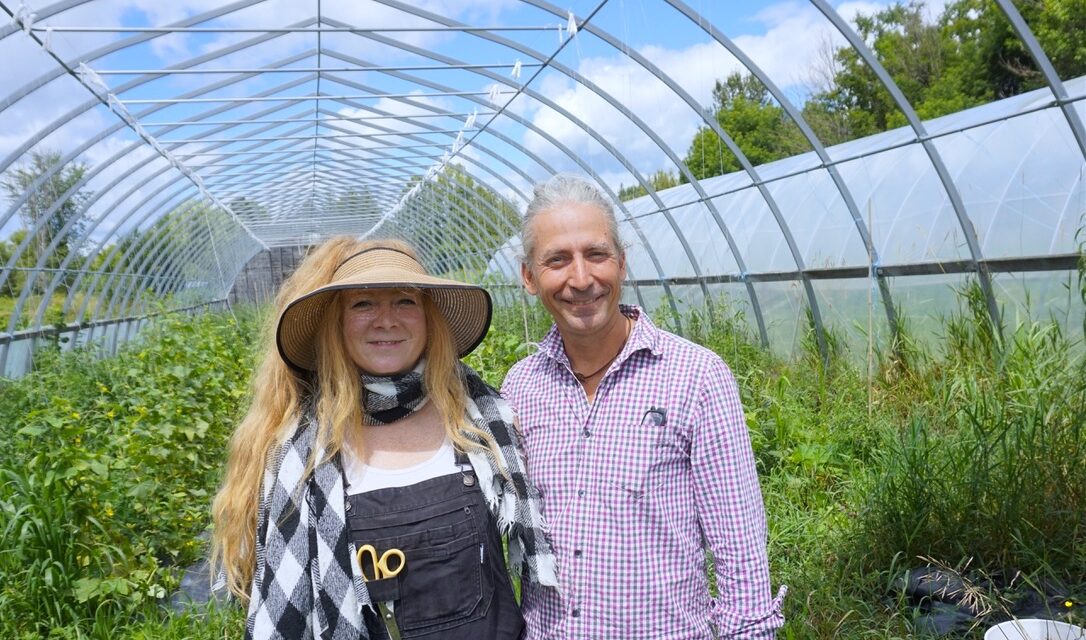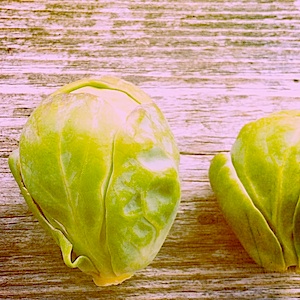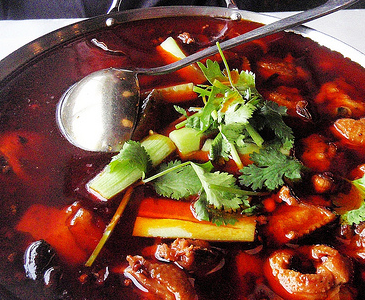For Matthew Brearley, farming his parents’ land was an inevitability, even if his first career choice of chef, and his teenage self might have said otherwise. “At age 14 or 15, I was working here on the farm and probably having this blow-up argument with my father, because he was telling me whatever I was doing was wrong, or I wasn’t doing it fast enough. And in my fury as a pubescent teen, I turned and said, Why don’t you get a real job? True story. I have subsequently eaten my words, realizing that, actually, this is the real job.”
Known in her family to have a “black thumb”, Tanya Sprowl didn’t see a future for herself that included farming. A graphic designer by trade, she hadn’t envisioned herself living in the country, planting and saving seeds, and hand-harvesting vegetables. “I never thought I would turn into a person—ever in my life—who would start dreaming of vegetables and farming, waking up in a panic wondering whether the heat is good in the greenhouse or if I had enough basil for the pesto I wanted to make. I never thought I’d be doing this. Never, ever in a million years.”
Yet here they both are at Castlegarth Farms in White Lake, Ontario, working and living together full-time as farmers.
A deep love for the environment, feeding people, and contributing to their community dictates so much of what happens at Castlegarth Farms daily. The rainbow of vegetables, flowers, herbs, and fruit that the land provides keeps Matthew and Tanya busy, dirty, and happy. When I visited the farm this summer, I glimpsed some of the wild, weedy magic and cheeky, colourful spirit that make this castle garden grow.
White Lake, Ontario —- It is a blue-sky summer day in July, and I’m a passenger in a truck traveling down the road to a vegetable farm, with a gentle black labrador retriever resting her head on my shoulder.
Is this heaven? I ponder, recalling Ray Liotta’s wonderment and awe in the movie Field of Dreams. If I had spoken these words aloud, the driver of the truck, chef, farmer, and forager Matthew Brearley might have replied with a witty smile, No, it’s White Lake.
Only a few minutes later, we arrive at the Brearley family farm known as Castlegarth—Old English for castle garden. The truck doors open and close, and Matthew, his partner Tanya, and I follow the family dog, Hecate, as she bounds through the field. Named for a Greek goddess associated with witchcraft and magic, this beautiful black creature leads the way, looking back as we walk as if to break the spell of city life and remind me where my food truly comes from.
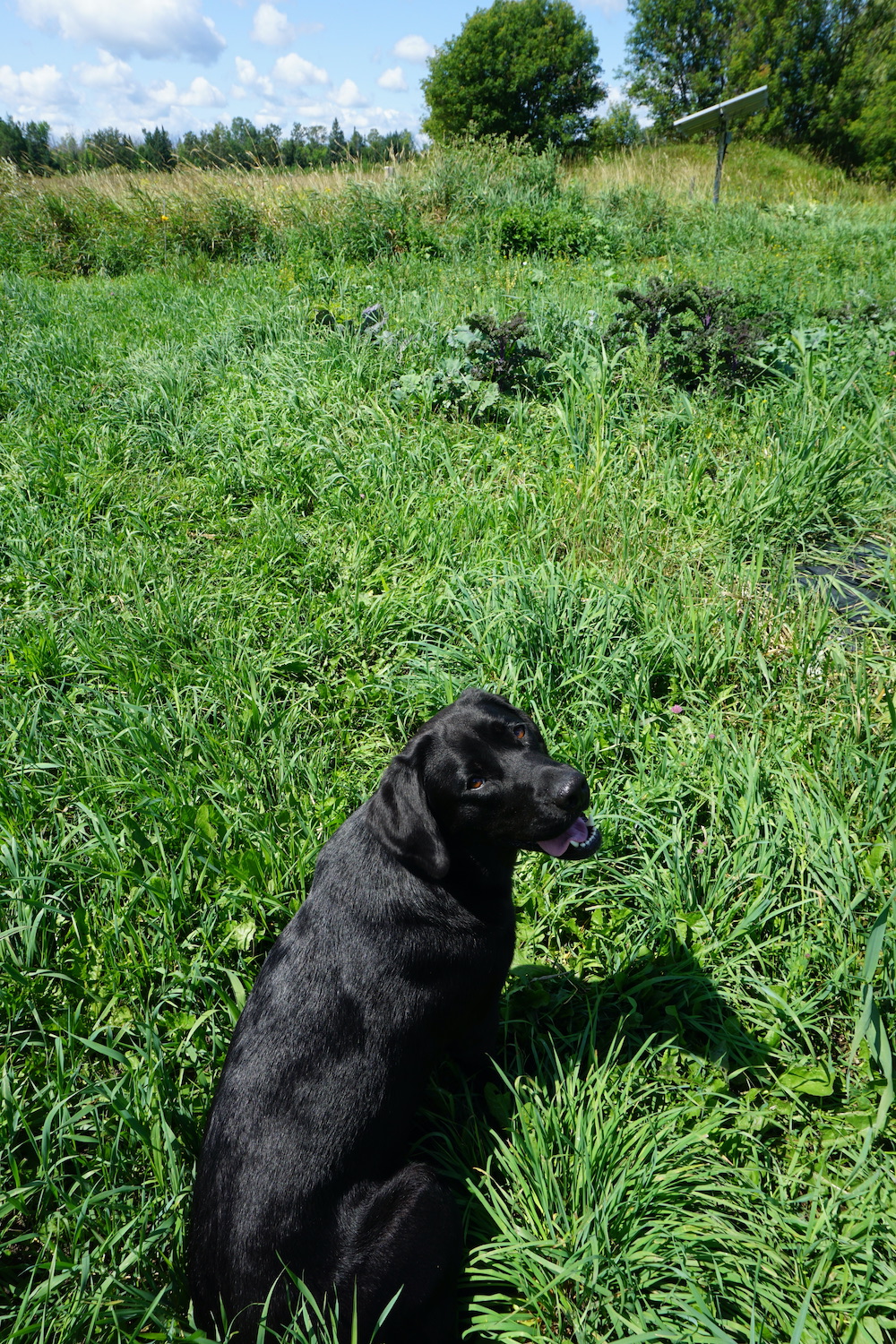
Hecate, our guide.
As we tour the farm, Tanya and Matthew begin to casually feed me. Tanya’s outstretched hand provides me with an atomic grape tomato, one of 65 varieties that are grown on the farm. This is followed by the juicy, crunchy taste of a silver slicer cucumber, so transparently greenish-yellow it almost shines. Beans are handed to me next, then more tomatoes. Tanya compares it to a ploughman’s lunch, and I’m enjoying it.
In part, tomatoes are how this all began. Matthew’s mother, Dianne, and his father, Michael, bought this 300-acre piece of land in 1972. The farmland itself dates back to around 1850 and today has 90 acres of arable land for farming, surrounded by a lush forest. Dianne tells the story to me as we sit on the quaint veranda at their home on the farm. “I was dreaming of a nice stone house in the country with maybe 50 acres of land, or maybe a little bit of woods, and he said, Oh, no, we’re having a farm!”
Michael, who instantly makes me laugh with his dry British humour, adds, “She wouldn’t have married me had she known that!”, to which he follows up with a sincere question, “If you live in the countryside, do you not want to enjoy it?”
Dianne did want to enjoy it, but she had more of a kitchen garden in mind. After purchasing the farm, they boarded cattle in the winter and eventually purchased their own, which at one point left Dianne delivering five calves on her own while Michael, then European Consultant for Huyck, was away on business. Dianne, then an English teacher at Arnprior District High School, hadn’t imagined 5:00 a.m. cattle feedings on top of a full-time job when she was dreaming of a charming country life. “I was taking a course, and I was trying to write an essay and running out to the barn and making sure the calves were alright”, she said. “So I put my foot down and said that’s enough. Michael said Okay, and I said, You have to make a choice (referring to his job at Huyck). So what did he choose? He chose the farm.”
Michael looks at her with a smile and asks somewhat rhetorically, “Well, aren’t you glad?”
Now known by loved ones as “The Tomato Lady”, Dianne hosts intimate tomato tastings for friends and family. Since the early days of the farm, her quest for tomatoes that tasted as good as those from her grandfather’s garden in Belleville, Ontario, has sparked a seed-seeking journey for her. “I started looking for a tomato that actually tasted like something. I grew one called Glamour, and I watched it ripen out in the garden—it was absolutely perfect. I picked it and sank my teeth into it, and it tasted like nothing! I didn’t even finish it; I just threw it out into the field.” Thus began her search for a tomato that actually tasted like a tomato.
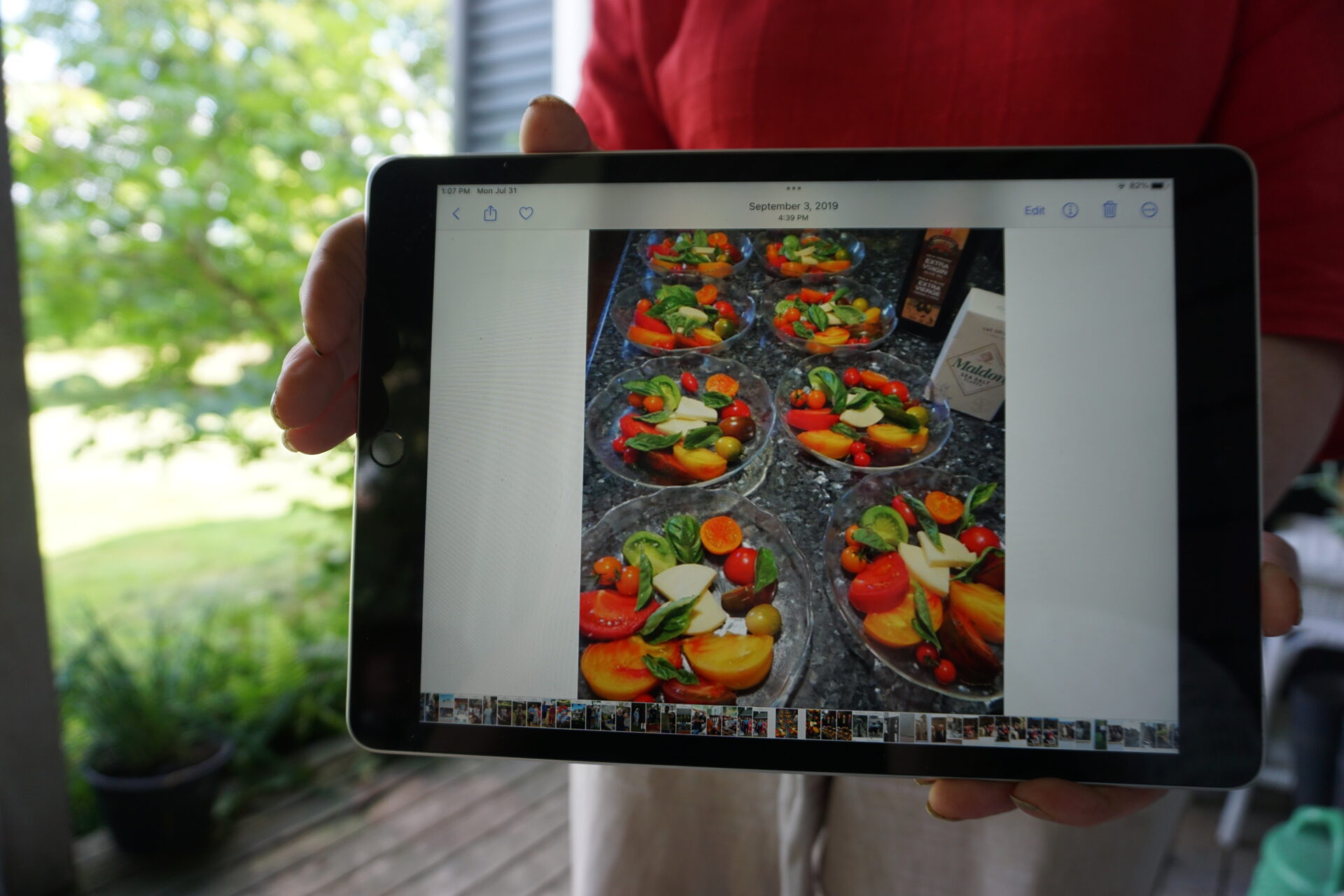
A photo from one of Dianne’s tomato tastings.
Years later, when Matthew was chef and co-owner of his former restaurant (also named Castlegarth), his own quest for delicious produce had him visiting the farm daily to gather ingredients. Matthew knew this land deeply from his youth, where he had been tasked with chores like picking weeds and potato bugs, but in this new context, it was like a portal opened up for him to truly appreciate organic farming. “When I had the restaurant, what made me realize what my parents had was that the produce I got would never taste as good as my parents’. Whether that was psychosomatic or reality, that’s when I realized what my parents had and what they were doing. That’s when I kind of had that sea change—you know, like maybe this is important”, he says.
Dianne is not surprised that Matthew’s journey has landed him here. “Looking after the farm—that was always the plan”, she says. “Well, I mean, he’s an only child—what are we going to do with it? So it would be his.”
Castlegarth Farms produces flowers, root vegetables, squash, herbs, beans, greens, garlic, peppers, eggplant, corn, radishes, apples, rhubarb, cucumber, melon, cauliflower, onions, and the aforementioned 65 varieties of heirloom tomatoes (including one called the Dancing Smurf and one named after Michael Pollan).
Early on in the life of the farm, Dianne and Michael travelled to Salt Spring Island, B.C., and met with a man named Dan Jason. Dan, a gardener originally from Montreal who has lived on Salt Spring Island since 1976, still owns and operates Salt Spring Seeds and advocates for people to “grow their own food and save their own seed”. “He eventually gave me my first heirloom seeds”, says Dianne, which inspired her to join Seeds of Diversity, a membership-based seed-saving organization where members shared amongst themselves. With a desire to not only share seeds but grow some unique varieties just for the farm, Dianne then purchased heirloom seeds by mail from Baker Creek Rare Seeds, which is now North America’s largest heirloom seed company. Today she also finds heirloom varieties from Greta’s Family Gardens, but many plants are grown on the farm by saving the seeds year after year. Lessons in seed-saving have come to the Brearleys simply from farming the land. Case in point: the “Jimmy” bean.
As we walk among rows of beans, Matthew explains, “The two rows here—when my parents first moved here, they met a guy who lived back in the bush. He gave them a handful of seeds and said, Here, grow these. So, they grew them, and they did really well. They flourished, but they’re dried beans, not fresh green beans. So, they ate them all up and went back to the guy and said, Well, where’d you get those bean seeds? We don’t have any, and we’d like to grow it again. And he’s like, You save ‘em. So he gave them another handful. To this day, we don’t know what this variety of bean is. It doesn’t look like anything that’s on the market. We call it the Jimmy Bean.” This mysterious bean has been growing on the farm for almost 50 years.
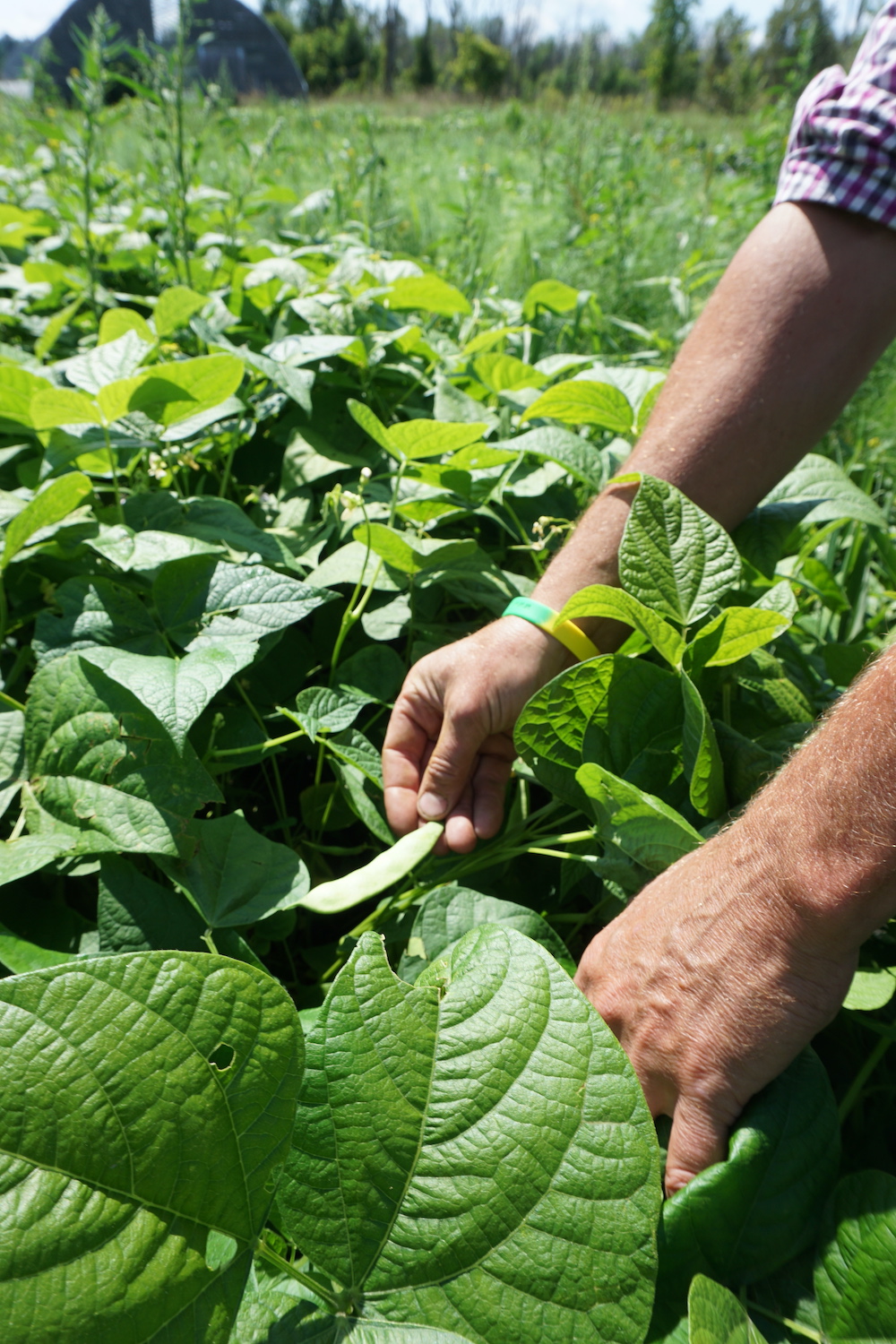
The Jimmy Bean
Matthew then tells me a story about another bean variety. “My mum grew for Canada’s Plant Gene Resources (PGRC)”, which he and Tanya explain is a seed-saving initiative by the federal government meant to gather and keep seeds for Canada. This bean was called “Coffinel”. “My mum kept growing it year on year, and it has been our staple green bean, but the weird part was, years afterward, my mum reached out to PRGC and said, Hey, you need to refresh your seed bank—we have been growing this for years; it came from you. And they were like, We have no record of this bean whatsoever.” He continues, “There’s one reference in France to a bean that was grown in Uganda, but that’s the only reference I’ve been able to find online about the Coffinel bean.”
Saving seeds is something Tanya quickly adopted as she started “drinking the Kool-Aid” of farming life with the Brearleys. Now, she’s practically bathing in it. “His mum is the original seed saver”, she states, adding that she does her best to continue Dianne’s seed-saving tradition. In contrast to the meticulous practice of seed-saving, Matthew and Tanya’s approach to farming seems to evoke a certain improvisational, DIY charm. Daily learning by simply working the land often yields unexpected benefits from perceived failures. Tanya’s latest foray into trial and error is her flower garden. When we walk by, she points it out, embodying an honest, can-do approach: “This is my flower garden…somewhat”, she said. “I mean, it’s my first time trying flowers. So I have some sunflowers coming up, but I don’t have time to keep on top of it. So we’ll just see what happens!”
Matthew points out another plant. “Here’s an example of seed-saving – this is parsley from last year; it survived. Historically, parsley around here didn’t survive the winter, but I’ve been noticing that there are some things that are surviving now that never used to due to climate change or whatever else. So, this will be parsley seed for next year. As you can see, we’ve got probably a billion seeds here.”
Tanya adds, “That’s also another good reason not to be super fastidious about your gardens, right? Rather than cleaning up and making your garden look pretty, you could just let it go naturally, and then the seed will dry, and in the fall you can collect it!” Her excitement is palpable. Tanya’s passion for saving seeds has resulted in both sharing and selling seeds such as pumpkin, black mint, dill, rhubarb, and lettuce.
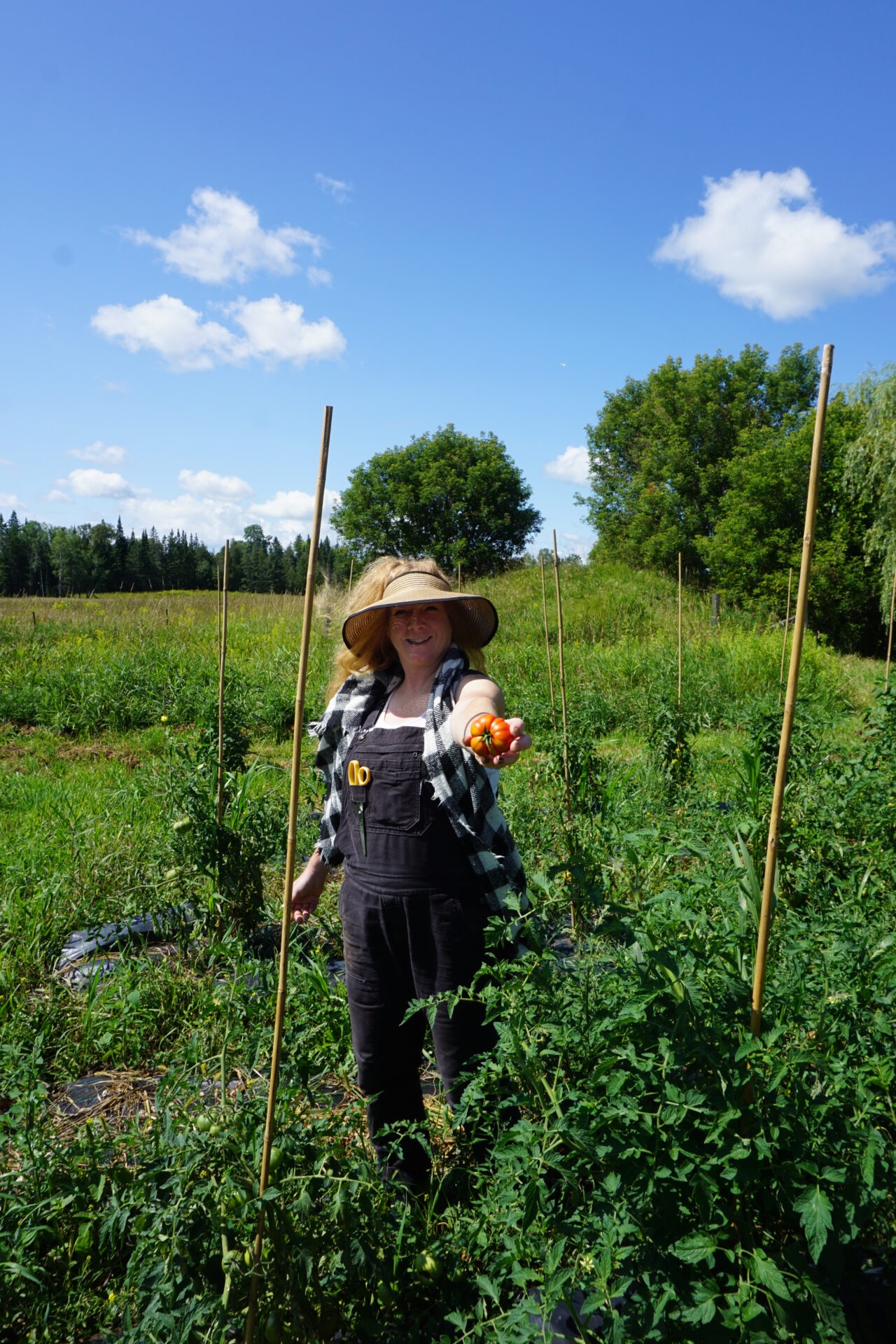
Tanya hands me a tomato.
When it comes to weeds, Matthew admits, “We’re not Instagram farmers”, making reference to the digital pictures we’ve all seen online of perfect garden rows. “I have always felt that a more natural approach is better”, he says, and he tells me how weeds can actually be beneficial. “When I was weeding the other day, I found a baby praying mantis in the long grass. If you don’t have this stuff, your insect predators have nothing to hide in. But on the other side of the coin, it’s really good for voles to hide in as well, and they delight in eating my beets. So basically, what we’ve come to do is plant more than we need so that we can essentially share with all the little critters.” He reaches down to show me yet another plant. Matthew says with a grin, “Another great thing about not being a diligent weeder: tomatillo.” He planted tomatillos 15 years ago and has never replanted them since. “It just comes up wild.” Another happy plant surprise has been elderflower, explains Matthew. “This is elderflower, and it grows all over the place. Tanya makes an elderflower cordial every year. It’s been one of our most popular sellers.”
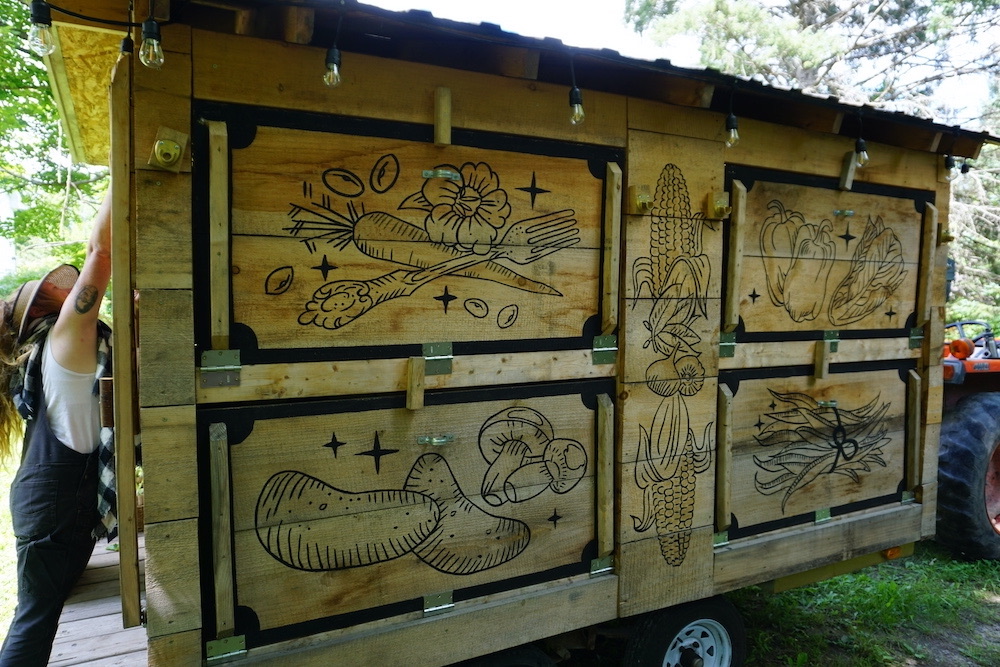
Tanya’s artwork, shown here on the farm cart.
Tanya’s enthusiastic energy and willingness to learn and get her hands dirty are not the only things she brings to Castlegarth Farms. Take one look at the farm logo, the hand-painted farm cart, the photos and stories shared on the Instagram account, and the creatively designed sustainable packaging on their food products, and you’ll see Tanya’s artistic voice everywhere. Still working as a graphic designer, Tanya deftly communicates the fun and irreverent spirit of Castlegarth Farms, and although Matthew says they’re not Instagram farmers, 1,000 followers might disagree.
Pre-pandemic, Matthew was cooking professionally and had transformed the kitchen of a local senior home by cooking everything from scratch. Just prior to that, in 2016, aided by the modern convenience of a dating app, he met Tanya. At the time, she was living in Ottawa, and they took turns travelling back and forth from the farm to the city. Over time, she began telling her friends she wanted to move.
In 2020, with the pandemic a reality and their relationship thriving, the time for Tanya’s move seemed right. She recounts, “My friends would be like, Oh my God, you’re not going to live in the middle of nowhere. You’re not even in a town; you’re in the bush!” A lively, social person, even Tanya wasn’t sure how she might fare living in the quiet country. “I needed space because I had a lot of stress and anxiety living in Ottawa.” When she would visit the farm, she could feel how it instantly improved her health, “I could almost feel my blood pressure drop at a certain point, coming up the road, and being at the garden and the farm.”
In 2021, Matthew quit his job at the seniors’ home and, with Tanya by his side, began farming full-time. “When I was a kid”, Tanya tells me with a self-deprecating laugh, “everybody knew I had a black thumb—I couldn’t keep a houseplant! Having been told your entire life that you have a black thumb and then all of a sudden being able to produce 150 feet of primo celery within one year, that was like, a-ha!” Her self-deprecation disappears. “My mom has a little joke—she said when I was a kid, if you ever want to get Tanya to do something, tell her she can’t. So, tell me I can’t farm, and I’ll prove you wrong!”
Speaking of primo celery, Tanya tells me the celery story. “When I met Matthew and I was moving in here, I’d seen a YouTube clip about regrowing celery from the stub. So I took this gnarly, decrepit, old butt of celery that was at the bottom of my fridge and planted it. Sure enough, it started sprouting, so I kept it as a house plant over the winter. When I moved in here with Matthew, I wasn’t gonna give up the prize celery that I was so proud of, so I planted it in a little container garden in the back of the house.” She smiles wide and exclaims, “Wouldn’t you know it? It grew into a massive tree; it was huge. And then it started seeding. I saved all that seed, and that’s the exact celery seed I used to plant 150 feet, and it was gorgeous. It was the best $5.99 purchase I had ever made!”
“There’s vegetables in these weeds!” Tanya exclaims as they talk about the wild weeds surrounding some of their beds. Pointing to one in particular, Matthew tells me, “This mess in here is actually strawberries. We’ve discovered that if we leave the weeds high on the strawberries, the deer won’t eat the strawberries on the ground, so instead, they eat all the things around them.”
He continues, “That’s the joy and the beauty of it because you’re constantly learning. This year we’re doing two sisters as opposed to three (three sisters: corn, beans, and squash)—we’ve got our winter squash interplanted with our corn.” He explains, “The reason for that is, the raccoons tend to not like walking through squash because it’s prickly and it hurts their paws.” He adds, humbly and honestly, “I think this will be a lost cause personally, but we’re going to try it.”
Another happy discovery was borage; after planting it, they discovered it was a natural bee attractant. “We have a symbiotic relationship with our neighbour who makes honey, so we continue to plant borage specifically to make the bees happy”, he says. “The bees come in for the borage, and they stay for the cucumbers and tomatoes.” This year, they plan to continue this relationship with their neighbour by planting buckwheat.
Leaving the honey production to their neighbour, Matthew and Tanya spend time in the off-season creating syrups, cordials, teas, and tinctures and preparing seed packets to sell and share. This past spring, they collected over 5,000 litres of sap to make their “Tree Blood”, (otherwise known as maple syrup), elderflower cordial,’shroom salt, pickled crabapples, and tinctures such as lion’s mane and reishi. Matthew also guides and educates groups on seasonal forager treks, where he shares his knowledge of mushrooms and wild plants such as lobster mushrooms, chanterelles, chaga, and wild ginger.
As we continue to travel lightly through the farm field, I ask Matthew about his farming philosophy, making reference to organic farming, permaculture, and regenerative farming. He replies, “I’m excited as much as I was by the farm-to-table revolution that happened 20-odd years ago by the regenerative agriculture movement that’s happening right now. It’s the first time I’ve seen the collective of society know that the system is broken. People are genuinely thinking more about where their food comes from, way more than they did before.” The farm isn’t certified, but it has been organic for 40 years. On the topic of permaculture, he brings up what he’s learned about making your own fertilizers.
“There’s a guy in Hawaii who I came across who makes his own fertilizers; it’s called Korean Natural Farming (KNF). Basically, what they do is get nutrients from plants and use them to feed other plants. So, essentially, what we’re trying to do is inoculate the seeds in the early germination stage with mushrooms, get them attached to that first, and then get them to join up with the roots to feed the plant itself. And then what we do is feed the foliage with these Korean Natural Farming extracts.”
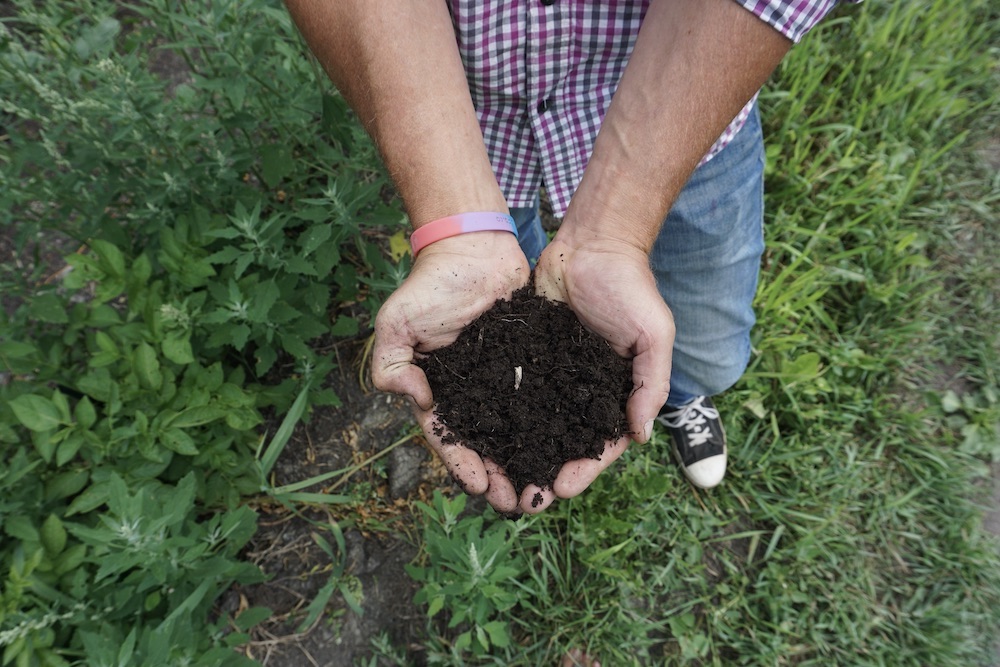
“We’re soil farmers” — Matthew
Matthew points to a field of corn, where three rows on one side look, in his words, “spindly and kind of gross”, whereas the ones in the next few rows, where he sprayed the roots with a compost tea made from worms and other nutrients, are tall and green. “I have learned more about soil science in the last two years. It’s like, all of a sudden, we’re realizing that we’re not plant farmers; we’re soil farmers. And the other crazy part of it is, we could actually really fight climate change in a huge way if we all start farming the way it should be.”
Listening to Matthew talk about farming methods, you can see his passion for soil science and new ways of growing food. He continues, explaining that farming small grains is his newest answer to what to do with 90 acres. “I can’t vegetable farm 90 acres—that’s crazy talk, especially not with just two people.” Currently, Tanya and Matthew harvest everything by hand, but they prep the beds by machine. “Tanya would be the diehard only-by-hand person, and I’m like, you know what, I’ll be 50 this year. And I would love to be able to do this on this scale when I’m 80, so I’m trying to find this nice hybridized version of small-scale and using machines to make life easier.”
One thing they agree on is that the health of a plant lies in the health of the soil, and this makes for healthier, more delicious food. Matthew cups some soil between his hands and holds it up for me to see. “In that little piece of dirt, there are probably four times the number of microbes in there than there are people on the planet. And each one of those is providing that plant with nutrients and all the things it needs. The buzzword right now is nutrient-dense food. Well, yeah – nutrient-dense food only comes when you give it the opportunity to get all the nutrients”, he says plainly.
“So, having this grass and this weed, everything in there together might look terrible, but there are microbes working with this plant that’s feeding this plant that can then share its things with this guy over here” (he looks over at another plant).
“And look at that forest”, he says, pointing to the forest that surrounds the farm. “There’s not one tree in there. There’s a tree, and there’s a shrub growing down. And there’s an understory with flowering plants. And even lower, there is grass underneath all that. These things are working together and feeding each other back and forth; I think that’s what we have to start understanding—that we need to be a part of the system rather than making the system.
As I listen to Matthew speak charismatically about plant diversity and soil science, I am also reminded of his recent run for town council in McNab/Braeside. I ask if he ran with an environmentally focused platform or to simply be more involved in his community, to which he replies, “A little from column A, a little from column B.”
Referring to the development of farmland, he says, “Part of it actually stemmed from the big box stores. On Hazeldean Road in Kanata, there’s this beautiful red barn that’s now being swallowed by development. That is arguably one of the reasons why I wanted to join municipal politics”, he says. “I’m not opposed to development, but when it comes to the fact we are building houses on Class A farmland…”
Tanya jumps in, “We’re losing 319 acres a day in Ontario of prime farmland to development. So, I’m all for intensification; people complain about condos, but sorry, we need to eat, so build up, not out.”
Matthew ended up losing that run by only seventeen votes. I ask him if he would do it again, and he says, “I might; who knows? But in hindsight, I don’t know if it wasn’t a blessing in disguise.”
He’s referring to the fact that by not winning the election, he found the time to kickstart a pilot program, “The Longer Table”, with the Greater Arnprior Community Council on Poverty and Homelessness. Inspired by work he did in the past with community food centres like Ottawa’s Parkdale Food Centre and The Table in Perth, and with a nod to the old adage that if you have more, you should build a longer table, not a taller fence, Matthew took his activism to the kitchen, teaching volunteers to use simple ingredients to create tasty, affordable, prepared meals. The meals are then frozen and given out to members of the community experiencing food insecurity who are accessing the Arnprior Food Bank.
Taking it a step further, Matthew shares, “My ultimate evolution would be—and it’s a far-fetched one—I would love to solely grow for food banks, but there aren’t grants in this country like there are in the States—there are farms in the States that do grow solely for food banks; they are education centres as well. I would love to just do that.”
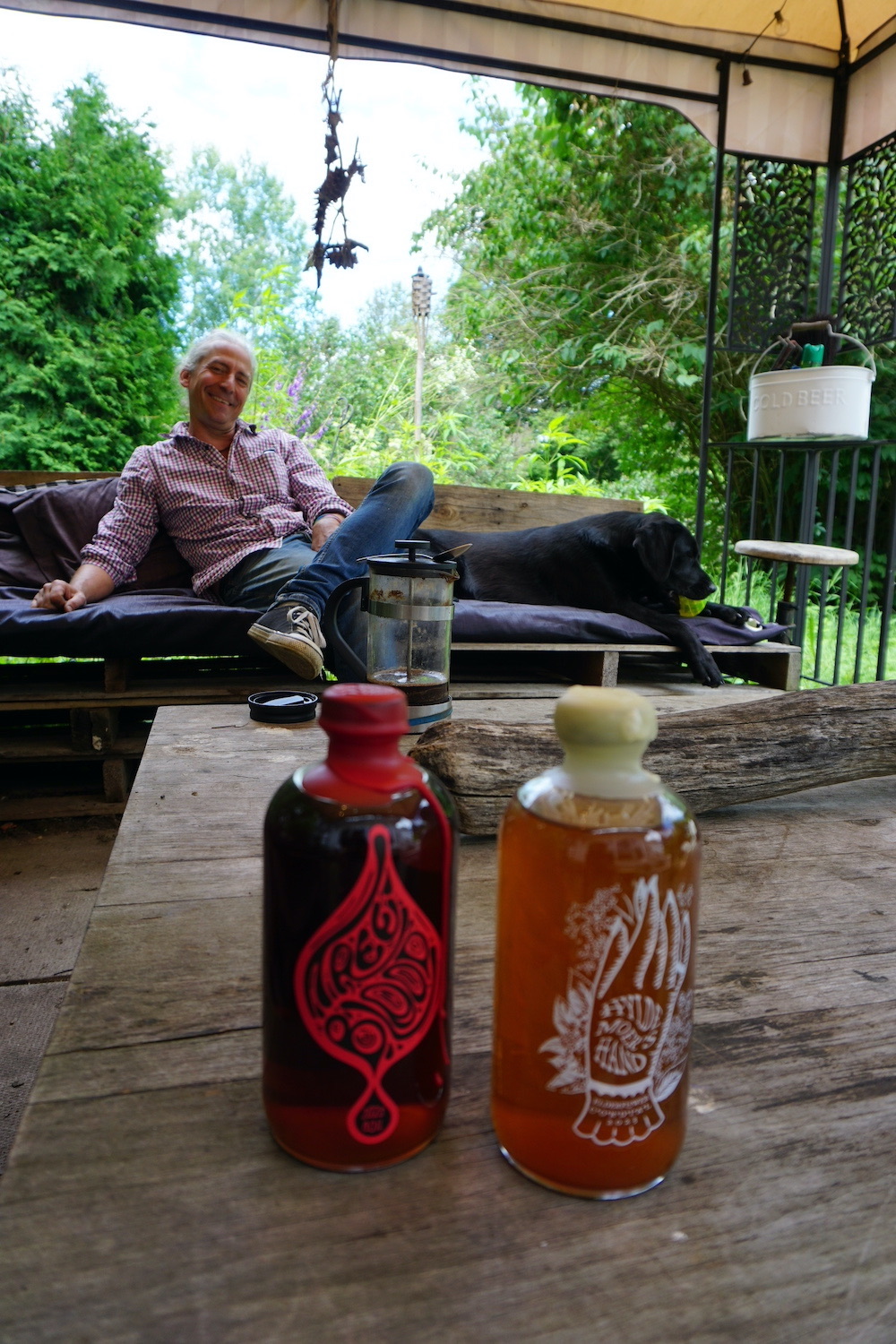
At home with Matthew and Hecate. I couldn’t go home without a bottle of tree blood and one of elderflower cordial. Tanya is nearby gathering seeds to share.
As we return from the farm to Matthew and Tanya’s cozy home, we take a seat on their back patio to wrap up our conversation. When the topic comes to the future of food, Matthew feels hopeful that more people will start to grow their own food. “Because of the pandemic and food prices, I firmly believe that people all of a sudden woke up to planting vegetables. I’ve noticed a change even in two years. Customers at the cart who say, Oh, I’m growing that in my garden at home.”
With all of the modern problems this world faces, I wonder aloud what it’s truly like to be a farmer in 2023, to which Matthew replies with a smile, “It’s the same as being a farmer in 1923 or 1823. Things haven’t changed that much. Basically, farmers buy everything at retail and sell everything at wholesale.” I add, “I guess the biggest change is climate change.” “Yeah”, Matthew agrees, “and also what I call the farmer’s lament. It’s either too hot, too cold, too wet, or too dry. It’s never the Goldilocks moment where everything is perfect. And you always have to remember, everything wants to eat what you planted.”
“Including us,” adds Tanya.
Before I say goodbye to Dianne and Michael, Matthew and Tanya, Hecate the magic dog, Beau the regal tuxedo cat, and a flock of happy chickens and roosters, I ask Matthew and Tanya what they’ve learned about themselves by doing this work. “The fact that we’re capable of a hell of a lot more than we thought we were”, Tanya answers confidently. Matthew refers to a microscope that Tanya and his mum bought him for Christmas, so he could watch the mycelium mushroom hyphae and look at the nematodes in the soil. “I’ve realized I truly love the science behind the growing”, he says. “It’s been fascinating; I haven’t lost my love for science, I guess, becoming a farmer.” I ask him if he thinks becoming a farmer has changed him as a person, to which he says, “I’m a happier person. I’m much happier than when I was in the restaurant industry.”
Although there are challenges to this work, both Matthew and Tanya seem to focus on the benefits. Matthew gestures to the green field in front of us and the beautiful blue sky, sparse with cotton-like clouds. “Just look at this—I’m outside in the sun and the fresh air, day in, day out.” Tanya agrees, “It feels good doing something with your hands too and getting dirty.”
Suddenly Matthew stops and says, “Wait…wait…listen: birds! Crickets! People listen to this with their headphones to try to calm down. I mean, look at this—the wind is blowing against you—what’s not to love? Like, seriously.” As he says this, I can’t help but think of what his father said about wanting to enjoy it.
In season, you can find Matthew and Tanya and their farm cart at the Kitchen at White Lake on Fridays, and at The Arnprior Farmers’ Market on Sundays. On Instagram and Facebook, you can find them at @castlegarthfarms. Click here for my 2010 story on Castlegarth the restaurant.

